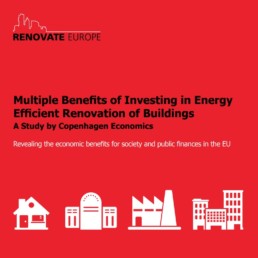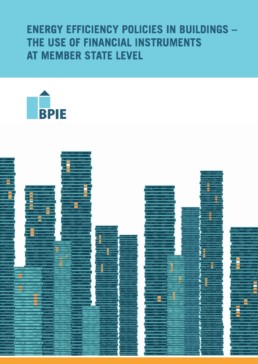EU institutions raise pressure for buildings renovation
The buildings sector will benefit from new legislation and guidelines to increase the renovation of EU buildings stock, according to energy commissioner Günther Oettinger. MEP Peter Liese says renovation is a more affordable way to tackle climate change than paying for renewables.
Brussels – The buildings sector will benefit from new legislation and guidelines to increase the renovation of EU buildings stock, according to energy commissioner Günther Oettinger.
Oettinger today welcomed a recent construction sector strategy report from enterprise commissioner Antonio Tajani, which encourages the renovation of both old and new EU buildings.
“Encouraging more renovation is an excellent way to make this sector start working again. The commission is keen to create the right conditions for more private-sector investment,” Oettinger said.
He said he also believed countries would go further with the renovation of existing buildings than is currently required by law.
An energy efficiency directive (EED), agreed in June, sets countries a binding target of renovating three percent of the floor area of public-sector buildings to meet minimum energy-performance standards.
Oettinger said he was confident many member states would broaden the three-percent target to more buildings.
Peter Liese, the German MEP who led the EED through the European Parliament, said investing in buildings renovation was the only way for countries to meet EU climate targets at the same time as saving money. “A strategy built only on renewables, particularly the way we are doing it in Germany, is very expensive,” he said.
“Energy efficiency is the cost-effective part of our climate strategy,” according to Liese. MEPs debating a commission renewable-energy strategy this week warned that the cost of renewables would become increasingly difficult for national governments to justify (see here).
Liese said that adding a long-term 2050 target for the energy efficiency of building stock to the EED was “one of parliament’s biggest achievements.”
He dismissed criticism that cutting energy needs through efficiency requirements would push the need for emissions-trading permits – and therefore their price – to even lower levels.
Efficiency standards for buildings are needed because “more than 50 percent of EU emissions are not covered by the Emissions Trading System (ETS),” Liese explained. “This is mainly [emissions from] buildings.”
Because the ETS was designed for large-scale industrial emissions, rather than smaller individual amounts of CO2 from buildings, he said there was unlikely to be a “reliable” way to include buildings in the trading system.
Both Liese and Oettinger were speaking at an event to launch a new study on the ‘multiple benefits of investing in energy efficiency of buildings.’ *
The study was written by Copenhagen Economics on behalf of the industry coalition Renovate Europe.
It finds that annual investments of 41-78 billion euros in buildings renovation in the EU will bring annual benefits of 104-175 billion euros by 2020.
Lower energy bills would account for 52-75 billion euros of the annual benefits. The rest would be thanks to reduced energy subsidies, reduced pollution and improved human health.
* Euroace, Renovate Europe Day, Brussels, 11 October 2012
Renovating Europe’s buildings could boost GDP by €291 billion by 2017
Investing in building renovation could accrue up to €175 billion per year for public finances with an additional “one-off” boost to GDP in the range of €153 to €291 billion for the years up to and including 2017. This is according to a new report prepared by Copenhagen Economics for the Renovate Europe Campaign.
The report which was launched at today’s Renovate Europe Day Conference2 , shows that when the challenge of renovating the EU building stock is taken up with a high level of ambition, permanent increases in revenue for public finances will result. The report also provides a number of policy recommendations for European governments to help boost public finances through renovation. These include shifting or reducing incentives such as favourable tax treatment of heating and electricity use in buildings to encourage a lower usage, thus rendering energy efficient renovation of buildings more attractive. Modernising rent regulation to allow landlords and tenants to share the gains from energy efficient renovations is another example.
Commenting on the report, , Adrian Joyce, Campaign Director of the Renovate Europe Campaign said “We know that many Member States are still hesitant about whether or not to invest in energy efficient building renovation programmes, despite the requirements of the recently adopted Energy Efficiency Directive3 . The findings in this new report will provide the final convincing arguments for those Member States, leading them to act. Investing in energy efficiency of buildings is a good investment in the short-term, the medium-term and the long-term.”
The second edition of Renovate Europe Day focuses on the theme of Stimulating Growth and Jobs in Europe.
In his address to the Conference, Günther Oettinger, EU Commissioner for Energy said “Energy efficiency is, for the European Union, the most direct and cost-effective way to achieve our strategic goals” and he goes on to elaborate on a number of key elements of EU Policy that go in this direction. He then turns to financing and informs the audience that: “…the European Union needs to focus and redirect its financial sources to address the energy efficiency financing challenge … That is why the Commission is keen to create the right conditions to bring more private sector financing into the energy efficiency market.”
The Renovate Europe Campaign is supported by 23 companies and associations.
IMPACT ON PUBLIC FINANCES
A STUDY BY COPENHAGEN ECONOMICS
Released at Renovate Europe Day, 11 October 2012
The Renovate Europe Campaign reached out to 28 Finance Ministers to highlight the Multiple Benefits of Investing in Energy Efficient Renovations as outlined in this Report.
Download the Key Messages Brochure
Download the Full Report and Appendix
Energy Efficiency Policies in Buildings - the Use of Financial Instruments at Member State Level
The BPIE report highlighted the complexity of the sector in large part because Member States had over decades separately developed their buildings sectors in terms of policies, design and construction techniques. The report showed a mosaic of building cultures and policies.
Policy-making cannot be undertaken effectively in a knowledge vacuum. With buildings representing about 40% of energy consumption and almost the same level of GHG emissions, there is a need for a strong analytical foundation for policy-making, particularly when there are priority policy concerns such as energy security and global climate change. Data and information are essential and the “Microscope” study started that data journey. The 2011 publication presented a fraction of the information and data collected. The database is now being used as an information pool to deepen the discussion in several key areas.
The 2011 report highlighted many of the market barriers that will impede such levels of energy performance improvements. The major set of barriers concerns the financing of such improvements. While the investments are considered cost-effective over the lifetime of the building, there are undoubtedly high up-front expenditures. The 2011 report gave some attention to the financial instruments available in Europe but, understandably, the review was only a first step.
This report takes a closer look at how financial instruments are currently being used in Europe and provides some evidence on their effectiveness. The focus is mainly on existing buildings, because these types of buildings represents the biggest potential for reducing GHG emission. New buildings only add about 1% per year to the total building stock. If buildings are to contribute their rightful share to the reduction of GHG emissions and energy savings by 2020 and 2050, the level of ambition must be high but must also be realistic, based on a strong analytical foundation. It is estimated that, on average, buildings can achieve 75-80% improvements in energy performance. What was once considered prohibitive is now widely accepted.
The Energy Efficiency Directive – Ready for Take-Off if Member States Act Decisively
Will the Energy Efficiency Directive, as agreed by the Member States, the European Parliament and the European Commission on the 13th June fly? It has elements in it that could, if properly and fully implemented at Member State level, see increased energy efficiency take-off, but its propositions on building renovations will not contribute as much as they could to the voluntary target of a 20% increase in energy efficiency by 2020!
For the existing EU building stock, the text is not as ambitious as it could have been as the Member States remain unconvinced about the huge social, environmental and economic benefits that building renovation programmes for each country can bring. The compromise reached on the renovation of public buildings (Article 4) limits required actions to central government buildings and thus to a tiny percentage of the overall building stock. In fact, the quantity of building included is so small that the market does not expect any stimulus effects to arise from this provision.
More promising is the inclusion (in a new Article 3a) of a requirement for each Member State to establish a long-term strategy for the renovation of the entire national building stock by April 2014. In this provision there is an opportunity for Member States to clear a path for a more prosperous, energy efficient and lowercarbon future as about 40% of all end-use energy is accounted for by buildings and about 32% of all carbon emission.
“To make the Directive fly and to ensure that it achieves the potential offered by the building stock of the EU, Member States will have to propose innovative, long-term, stable measures that take account of national conditions.” said Adrian Joyce, the Director of the Renovate Europe Campaign. “This can best be achieved by creating national building renovation roadmaps with a horizon of 2050 in which the goal is to reduce the energy demand of the EU building stock by 80% over current levels and the partners in the Renovate Europe Campaign are ready to assist in this endeavour.”
With a well-documented potential to create hundreds of thousands of long-term, stable, local jobs and with an average positive return on investment of over 12%, undertaking the extensive renovation of the EU building stock is a sure way to boost economic activity whilst also improving the built environment and hence the health of EU citizens.
Recognising the challenges ahead, Adrian Joyce adds: “Now that the text of the Directive is known, it’s time to roll up our sleeves, start work and get the buildings renovation sector off the ground!”



